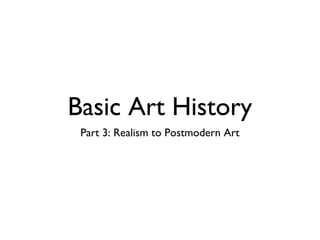
Realism to Postmodern Art History in 40 Characters
- 1. Basic Art History Part 3: Realism to Postmodern Art
- 2. Last class • Early Christian and Middle Ages- new art needed for new religion (Illuminated Texts and Architecture) • Byzantine Art- Architecture Christian and Islamic combined, Eastern Orthodox • Romanesque Art- first distinctive architectural style in Europe since Roman, used Roman stone construction methods • Gothic- pointed arches, vaulted ceilings, flying buttresses, open stone architecture, ornate • Renaissance- “rebirth”, renewal of classical humanism, order, harmony, idealism, nude bodies, science, mix secular, mythological and religious themes • Heightened realism with linear perspective, chiaroscuro • Leonardo daVinci, Michelangelo
- 3. Last class(cont.) • Renaissance to Modernism- Reformation and Counter reformation, growth in pluralism of religious ideas and social order, Revolution, Enlightenment • Baroque Art- propaganda for counter-reformation, focus on religion, more theatrical and dramatic, heightened chiaroscuro (tenebrism) • Baroque Artists- Rubens, Caravaggio, Bernini, Rembrandt • Rococo- French, more secular themes, meant for aristocracy, ornate curves and decoration, frivolous (Boucher, Fragonard) • Neoclassical- return to classical themes and forms, (David, Ingres) • Romanticism- embraced emotion, the exotic, dramatic, heroism (Gericault, Friedrich, Delacroix, Goya)
- 4. Modernism • Early Modernism- 1850 to 1945, Late Modernism 1945-1960/5 • Great societal change- industrialization, move from rural farms to city factories, big population boom, belief in progress and technology, utopian ideas, manifestos (Marx),World Wars • Art influenced by invention of camera which frees artists, much more focus on individual expression rather than skill, constant rejection of tradition or what came before • idea of “Avant-Garde” (advanced garde), pushing boundaries, radical • Realism (1850-70), Impressionism (1865-90), Post Impressionism (1880- 1920), Expressionism (1905-1925), Cubism (1906-15), Dada (1910-1920), Surrealism (1915-45),Abstract Expressionism (1945-60), Pop Art (1960s), Post-Modern 1970-? • art centers begin in Paris, after WW2 moves to NewYork
- 5. Realism • rejection of dominant Romanticism • focus on reality of modern life, depict harsh social realities • reject any religious, mythological, or historical themes • show dignity of common man, sympathy and admiration for peasants and field workers, for “everyman” • “Show me an angel and I will paint it.”- Courbet • Courbet, Millet, Manet
- 6. Gustave Courbet’s The Stone Breakers, 1850 Francois Millet’s The Gleaners, 1857
- 7. Edouard Manet Olympia, 1863 Luncheon on the Grass, 1863 Flatness, bold sexuality
- 9. Impressionism • Optical realism, continue interest in modern life • accurate depiction of light and its changing qualities with color, • painting directly from nature,“en plein air” • light effects made with many small brushstrokes of color • color theory (complementary, optical mixing) • new readily available paint in tubes in many colors • influenced my Japanese prints’ compositions (cropping) • Monet, Renoir, Mary Cassatt, Pissarro, Degas • also applied to music and literature
- 10. Claude Monet Haystack Paintings (1890-91)
- 12. Mary Cassatt The Boating Party, 1893
- 13. Edgar Degas Musicians in the Orchestra, 1872 L’Absinthe, 1876
- 14. Post-Impressionism • continued interest in color but for different reasons • Van Gogh- color for expression, emotion, wild brushstrokes • Paul Gauguin- color as symbol • Seurat- exaggerated optical color mixing (Pointillism) scientific • Paul Cezanne- color to depict essential structure
- 15. Van Gogh The Night Cafe, 1888
- 16. George Seurat La Grande Jatte, 1859-1891
- 17. Paul Gauguin Where do we come from? What art we? Where are we going?, 1897
- 18. Paul Cezanne Monte Sainte- Victoire, 1887 Bay of Marseilles, 1885
- 19. Expressionism • interest in interior life and emotion • influenced by psychology and psychoanalysis (Freud) • individual expression over realism or skill • combined the emotion ofVan Gogh with symbolism of Gauguin • applied to literature, poetry, music, theatre • Munch, Egon Schiele, Kandinsky, Max Beckmann
- 20. Edvard Munch Dance of Life, 1900 Madonna, 1894
- 21. Egon Schiele Male Nude with Red Cloth, 1914 Reclining Woman, 1915
- 22. Ernst Kirchner Self Portrait as Soldier, 1915
- 23. Cubism • influenced by Cezanne • more radical depiction of form from multiple angles • influenced by new ideas about space (Einstein) • rectilinear or geometric fragmentation • still life, portraits, landscapes • limited color range • combined imagery from different cultures and time periods (classical, tribal and archaic). • first use of collage materials in paintings • considered most influential art movement of 20th c. • Picasso, Braque, Juan Gris
- 24. Picasso and Braque Braque’s Violin and Candlestick, 1910Picasso’s Girl with a Mandolin, 1910
- 25. Les Demoiselles d’Avignon by Picasso
- 26. Dada • extreme rejection of tradition and former movements,“anti-art” • Artists affected by horrors of WWI, disillusionment with modern society • Use of humor, irony, the absurd, disorder and cacophony • multi-media, sound art and poetry, heavy collage • Duchamp, Kurt Schwitters, Hannah Hoch
- 28. Kurt Schwitters
- 29. Marcel Duchamp Readymades and Assisted Readymades, 1914-20
- 30. Surrealism • developed out of Dadaism • interest in subconscious, dreams • automatism- technique of writing and drawing using automatic, chance operations • photographic precision • strange juxtapositions, surprise, unnerving • Dali, Magritte, Max Ernst
- 31. Salvador Dali Geopoliticus Watching the Birth of the New Man, 1943 Persistence of Memory, 1931
- 32. Magritte Time Transfixed, 1939 Treachery of Images, 1928
- 33. Abstract-Expressionism • Post WW2 • center of artworld moves to NewYork City • mostly American • large scale painting, mixing cubist space with expressionist color and brushwork with Surrealist use of automatism • Pollock, DeKooning, Rothko
- 34. Willem DeKooning
- 35. Jackson Pollock
- 36. Mark Rothko
- 37. Edward Hopper
- 38. Grant Wood
- 39. Neo-Dada (late 50s) Jasper Johns Robert Rauschenberg
- 40. Pop Art Andy Warhol Roy Lichtenstein
- 41. Conceptual Art Joseph Kosuth On Kawara Rauschenberg’s Erased deKooning
- 43. Postmodern Art Kehinde Wiley Sherrie Levine
